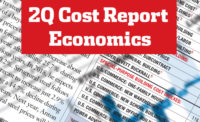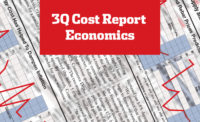As the COVID-19 pandemic crisis continues, economic consequences are being felt throughout the world, and the construction industry is no exception.
“For the last five to six years, [annual] construction cost escalation has consistently been in the range between 4% and 5% with occasional spikes higher,” says Julian Anderson, president of Rider Levett Bucknall. COVID-19 “has clearly impacted the bidding strategies of contractors and subcontractors.”
In the last quarter, inflation has been cut to 0.4%.
Private Sector Appetite
“Looking ahead, the key is just how quickly the economy recovers,” says Anderson, adding that it will hinge on “the appetite of the private sector to continue investing in developments and the financial ability of state and municipal governments to continue with their capital improvement projects.”
Overall construction starts have plummeted in the first five months of 2020, falling 12%, according to Dodge Data & Analytics. A number of high value projects—among them the $1.3-billion Manhattan West office tower in New York City, the $950-million expansion of the Portland International Airport in Portland, Ore., and a $1.3-billion widening of Interstate 635 near Dallas—broke ground this year. Still, nonresidential, residential and nonbuilding sectors all experienced declines compared to the January-May time period of 2019.
“The COVID-19 pandemic and recession have had a significant negative impact on the construction sector,” says Richard Branch, chief economist at Dodge, noting that only warehouse construction starts have increased during this time.
Nonresidential building starts bore the brunt of the overall decline, falling 19% through the first five months of the year. Nonbuilding construction also experienced a steep drop of 16% in the same time period. Due to a strong first quarter for single-family housing, residential work dropped only 3% in the same time period.
“May was likely the low point for the economy,” says Branch. “As businesses and local areas continue the reopening process, it will support a modest recovery in construction starts in the second half of the year.”
Moving forward, “consumer and business confidence will be a major factor in the path of this recovery, especially when considering the risk of a second wave of COVID-19 and/or more localized outbreaks as well as the waning positive impact of fiscal stimulus,” says Branch.
|
Related Link |
Bouncing Back
For commodities, prices have rallied since hitting a low point in April.
“Judging from the strength in commodities and U.S. equities, many market participants appear to anticipate a rapid recovery in the second half of this year, implying only a mild second wave of COVID-19 infections and few economic disruptions this fall,” says John Mothersole, director of research at IHS Markit.
Mothersole notes that while IHS Markit has raised its second and third quarter forecasts in the past six weeks, an overall decline is still expected in the long term. The IHS Material Price Index is still projected to be more than 10% lower at the end of 2022 than it was in the middle of 2019.
“Prices do recover over the near term, but the weakness in demand, coupled with the excess capacity it has exposed in many sectors means that the rebound in pricing will be prolonged,” Mothersole adds.
Structural steel prices are projected to drop 4.2% in 2020, slightly down from the first quarter’s projection of a 3.9% decline. IHS Markit projects an additional 4% drop in 2021 before prices rally 2.5% in 2022.
“[Steel] mills are now pushing for price increases,” says John Anton, associate director of pricing and purchasing at IHS Markit. However, he says, “risk aligns on the downside,” as a second wave of COVID-19 could lessen product demand.
“Upside risk is that mills idling create a short supply tightness once demand picks up. Such a tightness—and price jump—would be very short-lived, as mills would restart furnaces at the first chance,” says Anton.
Lumber prices are expected to fall 0.7% in 2020, according to IHS Markit’s second quarter forecast. The decline marks a big shift from the first quarter projection, a 4.6% increase. IHS Markit expects a rebound of 1.1% in 2021, followed by a 3.3% boost in 2022.
Looking at Labor
On the labor side, the latest Construction Labor Research Council report on union labor trends shows the compensation package is highest in the Middle Atlantic region, which includes Washington, D.C., Delaware, Maryland, New Jersey, New York and Pennsylvania, at $69.40 per hour.
The lowest wage, at $42.11 per hour, is in the South Central region, including Arkansas, Louisiana, New Mexico, Oklahoma and Texas. The average hourly U.S. package is $57.13. Overall total first year packages rose 2.9% in 2019, while total package increases for all contract years grew by the same amount in the same time period.
By trade, the firm reports that boilermakers are earning the highest rate at $66.93, with plumbers and pipefitters not far behind at $65.61 and $65.33, respectively. On the lower end of the spectrum, laborers earn $46.12 an hour, with roofers at $46.37.






Post a comment to this article
Report Abusive Comment